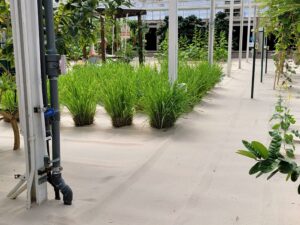Merle Jensen was a visionary horticulturist and expert in hydroponic greenhouse culture. He earned academic credentials as a professor at the University of Arizona, demonstrating his qualifications and credibility in the field.
Jensen conducted innovative research on utilizing sand as an effective substrate for growing plants. His findings showed that sand could provide an optimal medium for plant growth and nutrition. This research paved the way for new models of sustainable agriculture.
In addition to his academic work, Jensen played a key role in the development of the iconic Land Pavilion at Disney’s Epcot Center in Florida. He helped design and install the sand filters used in the facility’s groundbreaking systems that display future-focused solutions for food production.
As one of the pioneering researchers in sand culture, Merle Jensen left a legacy that still influences modern sustainable agriculture. His interdisciplinary approach spanning both commercial and educational projects embodies the spirit of innovation we aim to carry forward.
As one of the principle consultants on the iAVs research team, Jensen lent his expertise to help create a revolutionary method of sustainable food production.
Jensen was a professor at the University of Arizona focused on greenhouse crop production and hydroponics. His research demonstrated sand to be an effective substrate for growing plants, and that it could effectively filter and purify water in recirculating hydroponic systems. These findings were fundamental building blocks that enabled the fundamentals of iAVs.
Throughout his career, Jensen was driven by a passion to push the boundaries of what was possible in controlled environment agriculture. He channeled his deep expertise and creativity into sustainable solutions that could produce abundant, nutritious crops anywhere in the world. These qualities made him an invaluable member of the iAVs team.
As we continue refining and promoting this sustainable method of food production, we honor Merle Jensen for the integral role he played in iAVs’ conception. This innovative system stands on the shoulders of visionaries like Jensen who devoted their lives to advancing agricultural science. Our whole team is deeply inspired by his contributions.
——————————————————————————————————–
This blog is part of a series where we examine the members of the iAVs research team.
The research team for the Integrated AquaVegeculture System (iAVs) is distinguished by its scientific rigor and the credentials of its members. During the foundational research phase from 1984 to 1994, the team consisted of seven co-investigators from five disciplines, nine principal consultants, and contributions from over four dozen other consultants and technicians. This multidisciplinary team published work in five peer-reviewed journals and collaborated with faculty from 16 departments within the College of Agriculture and Life Sciences, as well as other institutions.
The credibility of iAVs is further enhanced by the involvement of recognized professionals from various fields around the world. The research team has also collaborated with contributors from over 30 external institutions, including the USDA, which conducted a two-year commercial demonstration project.
This extensive collaboration and the team’s scientific background differentiate iAVs from similar systems. It is the only system in its category supported by credible science, research papers, and a significant trial period conducted under the auspices of the USDA.
The team’s dedication to empirical evidence and peer recognition, with 10 members being honored as “Fellow” in their respective fields, highlights the scientific foundation of iAVs.
Click here for the full list of the iAVs Research Team.

 Creative Commons Attribution-NoDerivs
Creative Commons Attribution-NoDerivs